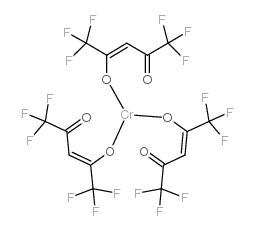14592-80-4
| Name | chromium (iii) hexafluoroacetylacetonate |
|---|---|
| Synonyms | MFCD00044995 |
| Boiling Point | 70ºC at 760 mmHg |
|---|---|
| Melting Point | 83-85ºC |
| Molecular Formula | C15H3CrF18O6 |
| Molecular Weight | 673.14800 |
| Flash Point | 30.8ºC |
| Exact Mass | 672.90500 |
| PSA | 78.90000 |
| LogP | 6.13470 |
| Vapour Pressure | 131mmHg at 25°C |
| Water Solubility | Insoluble in water |
|
Section 1: Product Identification Chemical Name:Chromium (III) hexafluoracetylacetonate, min. 98% CAS Registry Number:14592-80-4 Formula:Cr(CF3COCHCOCF3)3 EINECS Number:none Chemical Family:metal fluorobeta-diketonate complexes Synonym:chromium (III) hexafluoro-2,4-pentanedionate; Tris(1,1,1,5,5,5-hexafluoroacetylacetonate)chromium (III)
Section 2: Composition and Information on Ingredients IngredientCAS NumberPercentACGIH (TWA)OSHA (PEL) Title compound14592-80-4100%0.5mg/m3 (as Cr)0.5mg/m3 (as Cr) Section 3: Hazards Identification Emergency Overview:Irritating to skin, eyes and respiratory tract. Primary Routes of Exposure:Ingestion, inhalation Eye Contact:Causes slight to mild irritation of the eyes. Skin Contact:Causes slight to mild irritation of the skin. Inhalation:Irritating to the nose, mucous membranes and respiratory tract. Ingestion:Ingestion may cause gastrointestinal distress, burning of throat, dizziness, and weakness. Acute Health Affects:Irritating to skin, eyes and respiratory tract. Chromium salts have behaved as tumorigens and mutagens in animal studies. Product contains fluorine which Chronic Health Affects:may generate fluoride ion causing vomiting, labored breathing, hypocalcaemia, deterioration of bone and tooth structure, kidney and liver damage. NTP:Yes IARC:Yes OSHA:No SECTION 4: First Aid Measures Immediately flush the eyes with copious amounts of water for at least 10-15 minutes. A victim may need Eye Exposure: assistance in keeping their eye lids open. Get immediate medical attention. Wash the affected area with water. Remove contaminated clothes if necessary. Seek medical assistance if Skin Exposure: irritation persists. Remove the victim to fresh air. Closely monitor the victim for signs of respiratory problems, such as difficulty in Inhalation: breathing, coughing, wheezing or pain. In such cases seek immediate medical assistance. Seek medical attention immediately. Keep the victim calm. Give the victim water (only if conscious). Induce Ingestion: vomiting only if directed by medical personnel. SECTION 5: Fire Fighting Measures Flash Point:no data Autoignition Temperature:no data Explosion Limits:no data Extinguishing Medium:carbon dioxide, dry powder or foam. If involved in a fire, fire fighters should be equipped with NIOSH approved positive pressure self-contained Special Fire Fighting Procedures: breathing apparatus and full protective clothing. Hazardous Combustion andIf involved in a fire this material may release toxic chromium oxide and organic fumes. Decomposion Products: Unusual Fire or Explosion Hazards: No unusual fire or explosion hazards. SECTION 6: Accidental Release Measures Small spills can be mixed with vermiculite, sodium carbonate or other suitable non combustible adsorbent and Spill and Leak Procedures: swept up. SECTION 7: Handling and Storage Handling and Storage:Store the material in a tightly sealed container. Keep away from heat and moisture. SECTION 8: Exposure Controls and Personal Protection Eye Protection:Always wear approved safety glasses when handling a chemical substance in the laboratory. Skin Protection:Wear protective clothing and gloves. Ventilation:Material may form a fine dust. If possible, handle the material in an efficient fume hood. If ventilation is not available a respirator should be worn. The use of respirators requires a Respiratory Respirator: Protection Program to be in compliance with 29 CFR 1910.134. Ventilation:Material may form a fine dust. If possible, handle the material in an efficient fume hood. Additional Protection:No additional protection required. SECTION 9: Physical and Chemical Properties Color and Form:green xtl. Molecular Weight:673.14 Melting Point:83-85° Boiling Point:no data Vapor Pressure:no data Specific Gravity:no data Odor:not determined Solubility in Water:insoluble SECTION 10: Stability and Reactivity Stability:air and moisture stable Hazardous Polymerization:No hazardous polymerization. Conditions to Avoid:none Incompatibility:oxidizing agents and active metals Decomposition Products:organic fumes, carbon monoxide, carbon dioxide, hydrogen fluoride and chromium oxide. SECTION 11: Toxicological Information RTECS Data:No information available in the RTECS files. Carcinogenic Effects:no data Mutagenic Effects:no data Tetratogenic Effects:no data SECTION 12: Ecological Information Ecological Information:No information available SECTION 13: Disposal Considerations Disposal:Dispose of according to local, state and federal regulations. SECTION 14: Transportation Shipping Name (CFR):Non-hazardous Hazard Class (CFR):NA Additional Hazard Class (CFR):NA Packaging Group (CFR):NA UN ID Number (CFR):NA Shipping Name (IATA):Non-hazardous Hazard Class (IATA):NA Additional Hazard Class (IATA):NA Packaging Group (IATA):NA UN ID Number (IATA):NA SECTION 15: Regulatory Information TSCA:Not listed in the TSCA inventory SARA (Title 313):Title compound: See category code N090 for reporting. Second Ingredient:none SECTION 16 - ADDITIONAL INFORMATION N/A |
| Risk Phrases | R20/21/22 |
|---|---|
| Safety Phrases | 23-36/37/39 |
